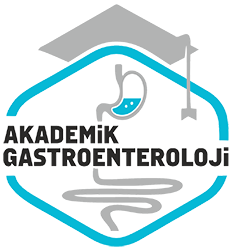Çocukluk çagi akut ve perfore apandisitlerinde ultrasonografik bulgularin tani değerleri*
Diagnostic values of ultrasonographic criteria in the diagnosis of childhood acute and perforated appendicitis
- Ana Sayfa
- Sayılar
- Çocukluk çagi akut ve perfore apandisitlerinde ultrasonografik bulgularin tani değerleri*...
Dr. Behçet Uz Çocuk Hastanesi Radyoloji Bölümü2, Izmir
Gaziantep Üniversitesi Tip Fakültesi Çocuk Cerrahisi Anabilim Dali3, Gaziantep
Adnan Menderes Üniversitesi Tip Fakültesi Çocuk Cerrahisi Anabilim Dali4, Aydin
Sakarya Dogumevi Çocuk Cerrahisi Klinigi5, Sakarya
Özet
Giriş ve amaç: Akut apandışıtli (AA) çocuklarda apandiks ve periapandiküler bölgenin ultrasonografik görünümü, enflamasyonun derecesine ve perforasyon varligina bagli olarak değişkenlik göstermektedir. Bu çali smanin amacı preoperatif ultrasonografik (USG) incelemesi yapilmis olan akut (AA) ve perfore (PA) apandışıtli olgularimiza ait ultrasonografik bulgularin tanı değerlerini her iki grup için ayri ayri incelemek ve yayi nlanmis veriler ile karsilastirmaktir. Gereç ve yöntem: çalışmanın materyalini Ocak 1997- Mart 2000 yıllari arasında apandışıt nedeni ile opere edilen 188 olguya ait preoperatif USG bulgulari olusturmaktadır. Olgularin USG incelemesinde kullanılan parametreler sırasıyla apandikse ait patolojik kitle görünümü (A), apandikolit (B), apandiks duvar kali nligi (tüm apandiks çapi)’nin mm cinsinden ölçümü (C), periapandiküler bölgede, pelvis veya Douglasda lokalize sivi (D), yaygin periton içi sivi (E), ileus bulgulari (aperistaltik dilate barsak anslari) (F) ve normal ultrasonografik bulgular (G)’dir. Her iki gruptaki apandiks duvar kalinli klari arasındaki farklilik istatistiksel olarak incelenmıştır. Bulgular: Ultrasonografik ölçüm parametrelerinin her iki gruptaki toplam 188 olgudaki dagilimi (olgu sayisi) Akut apandışıtli olgular için: (A)61, (B)6, (C)51, (D)16, (E)8, (F)25, (G)20 ve Perfore apandışıtli olgularda: (A)42, (B)9,(C)31, (D)29, (E)14, (F)24, (G)10 seklindedir. Her iki grubun apandiks duvar kalinliklari (C) AA için ort. 19,37 (±12,55) mm; PA için ise ort. 23,80 (±15,10) mm olarak hesaplandi. AA ve PA için USG ile ölçülen apandiks duvar kalinliklari arasında istatistiksel olarak anlamli bir fark saptanmadi (p>0,05). Apandiks duvar kalinligi bir olgu hariç tüm olgularda (81 olgu) 6mm ve üzerinde bulundu. PA grubunda %34,9 orani nda intraperitoneal sivi birikimi gözlendi. Sonuç: USG apandışıt tanı- sinda güvenilir ve noninvaziv bir yöntem olup 6 mm’den büyük kitle görüntüsü tanıda önemlidir. Apandışıt perforasyonu ile birlikte sonografik bulgularin görülme sikligi artmakta, apandiks çapi artmaktadır. Her iki grup arasında ileus bulgulari yönünden önemli bir fark olmamasi, bu kriterin akut apandışıtin ultrasonografik tanısında yararli olacagini düsündürmektedir.
Abstract
Background and aims: The ultrasonographic (USG) appearances of the appendix and periappendicular regions differ according to the degree of inflammation as well as the presence of perforation in children with acute appendicitis. The aim of this study was to evaluate the diagnostic value of ultrasonographical findings in patients with acute (AA) and perforated appendicitis (PA) with preoperative ultrasonographic investigations and to compare the results with the previously published data. Materials and methods: The material of this study included data regarding the ultrasonographical evaluation of 188 patients treated with the diagnosis of appendicitis in the period January 1997- March 2000. The parameters of USG evaluation were: the appearance of pathological appendiceal mass (A), appendicolith (B), diameter of the appendiceal wall (entire appendix) in mm (C), localized fluid in periappendicular region, pelvis, or Douglas (D), diffuse intraperitoneal fluid (E), findings of ileus (aperistaltic, dilated bowel loops) (F), and normal ultrasonographic findings (G). Appendiceal wall mass was calculated in both groups, and the difference was compared statistically. Results: The distribution of ultrasonographic parameters in each group for a total 188 patients were as follows: (A)61, (B)6, (C)51, (D)16, (E)8, (F)25, (G)20 for acute appendicitis; and (A)42, (B)9, (C)31, (D)29, (E)14, (F)24, (G)10 for perforated appendicitis. The average value for appendiceal wall thicknesses was calculated as 19.37 (±12.55) mm for AA, and 23.80 (±15.10) mm for PA. The difference between the two groups was not statistically significant. Appendiceal wall thicknesses were greater than 6 mm in all patients (81) except one. Intraperitoneal fluid collection was detected in 34.9% of the patients for the PA group. Conclusion: USG is a reliable and non-invasive method in the diagnosis of acute appendicitis; the appearance of ‘mass’ bigger than 6 mm in diameter is valuable in diagnosis. The incidence of sonographic findings and the measurement of the appendiceal wall increase in case of perforation. Because there was no important difference between the ileus findings of the two groups, we think it can serve as a useful criterion in the ultrasonographic diagnosis of acute appendicitis.



